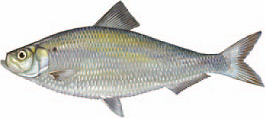Alewife
Life History
Alewife (Alosa pseudoharengus) and blueback herring (Alosa aestivalis) are collectively known as river herring. They belong to the shad and herring family (Clupeidae). These two species share a similar life history and are almost identical in appearance. Like the American shad, river herring are anadromous spending the majority of their lives at sea and returning to freshwater areas to spawn each spring.

- Overall silvery color, usually with metallic grayish green color on top
- Eye diameter greater than snout length
- Body is strongly compressed and less elongated giving it a wider girth than a blueback herring
- Abdomen with sharp scutes along midline
- Usually one small dark spot located on the upper side of the body just beyond the gill plate (present in fish greater than 10cm TL)
- Peritoneum (lining of the abdominal cavity) is pale or light in color, occasionally with small light spotting
- Reach a maximum length of 40cm (16 in.)
Range along the Atlantic coast from Labrador, Canada to South Carolina. Alewives arrive to spawn before blueback herring. Peak spawning occurs in Virginia from late March through April, when water temperatures are between 15 and 17° C. Alewives prefer to spawn in shallow sluggish waters along large rivers, small streams and ponds. Spawning occurs over a wide range of substrates including: gravel, sand, detritus and submerged aquatic vegetation. Females can release 60,000 to 467,000 eggs per season. Once the eggs are fertilized they will hatch within 2-6 days, depending on water temperature. After spawning, adults will migrate downstream returning to the ocean. Juveniles will remain in freshwater during the spring and summer. They begin a gradual seaward migration as water temperatures begin to drop in the fall. However, some will remain in deeper waters of the Chesapeake Bay and its tributaries for their first winter. Alewives consume a wide variety of zooplankton including: copepods, amphipods, mysids, ostracods and euphausiids. Adults also feed on small fishes, shrimp, insects and fish eggs. They exhibit a diel vertical migration; they appear at shallower depths at night and descend to deeper water during daylight hours. Adult Alewives remain at sea in large schools until they reach sexual maturity between 3-5 years of age. Mature adults will return to their natal rivers to spawn each spring.

